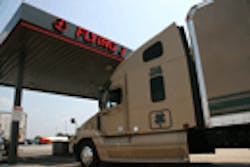High diesel fuel prices are having a ripple effect throughout the economy, but the resulting impact to trucking is a little harder to quantify, according to several experts.
“The prices have started to stabilize,” Eric Starks, president of FTR Associates, said. “I think there is a general consensus that we’ve reached the peak.”
Average diesel prices surpassed $4/gal. before the calendar turned to May, but that hasn’t significantly changed equipment purchasing habits, according to Starks, who noted that April Class 8 truck orders increased considerably despite the rapid rise of diesel fuel.
“It tells me that fleets are not as concerned with fuel prices at this time because the underlying economy [is doing better],” Starks said.
ACT Research reports that April orders for Class 8 tractors jumped 158% over April 2010, with the industry on track for 245,000 to 250,000 new North American orders in 2011, up from 154,000 in 2010.
“[Fleets] are replacing existing equipment,” said Steve Tam, vice president-commercial vehicle sector for ACT Research. “If we didn’t have the fuel prices we have now, we might see more” order activity.
According to FTR data, the Trucking Conditions Index reached 13.3 in March, up from 9.92 in February. Any reading above 10 is an indication that volumes, prices, and margins are in a good range for trucking companies, and that freight volume has minimized the impact fuel prices are having.
Lana Batts, , a principal of transportation consulting firm Transport Capital Partners, thinks higher fuel prices will have a significant impact on purchasing decisions as fleets, particularly smaller operations, may need that cash for fuel.
“A lot of companies must have money in their accounts before they can pump any fuel,” Batts, said. “Even if you have a shipper who pays in 30 days, you’re still 30 days short.”
One concern regarding high diesel prices is whether many smaller carriers and owner-operators will be forced out of the business. Tam doesn’t believe that will happen in significant numbers, although Batts disagrees with that assessment.
“As fuel prices increase, we will see some truckers exit the space,” Tam said, “but we’re not expecting a rise in bankruptcies.”
“Here is this guy grasping for breath anyway,” Batts countered, suggesting that increased fuel costs could have a trickle-down effect for carriers.
Bankruptcies are significantly lower through the first quarter of 2011 than they were in 2010. Only 295 trucking companies filed for bankruptcy in the first quarter of this year, taking a total of 5,420 trucks off the road, compared to 730 and 33,360 trucks in the first quarter of 2011, according to Donald Broughton, senior research analyst and managing director at Avondale Partners.
“This is a period in which we are not going to have many companies going out of business,” he said. “The underlying economy is doing better, and if [the companies] made it through 2008” then they have the experience to survive this time, particularly with the improved freight market.”
Batts suggested that the effect of higher prices could ultimately impact the ability of some carriers to retain current and attract new drivers.
“As carriers say, ‘How am I going to keep and attract drivers,’ drivers are saying, ‘Why do I want to drive older equipment,’ ” Batts argues. “Whether it is a factor yet, it is clearly under the surface.”
For drivers, whose careers are now dependent on recording good CSA scores, the simple fact that a job exists may not be enough to lure them into the cab.
“The thing that changed with the [pre-employment screening program and CSA] is it’s no longer [the driver’s] job at risk, it’s [the driver’s] profession at risk,” Batts said.
Of more immediate concern to both Tam and Starks is the impact higher gasoline prices will have on consumer buying habits and, ultimately, the amount of freight to be moved.
“Every penny increase we see in the price of fuel takes a significant amount of money out of freight,” Tam said.
“What does the consumer do?” Starks asked. “Do they scale back what they buy or do they just scale back on their driving habits?” As long as the consumer is still purchasing, and indications lead experts to believe they still are, then there will be freight to be moved.”
